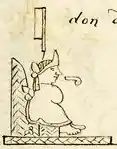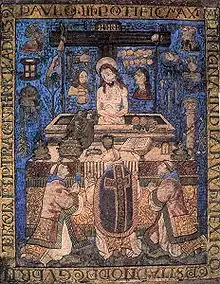Diego de Alvarado Huanitzin
Don Diego de Alvarado Huanitzin (or Panitzin) was a 16th-century Nahua noble. A grandson of Axayacatl, Nephew of tlatoani Moctezuma II. He was initially the tlatoani (ruler) of Ecatepec before becoming tlatoani of Tenochtitlan, as well as its first governor under the colonial Spanish system of government.
| Diego de Alvarado Huanitzin | |
|---|---|
 | |
| 15th Tlatoani of Tenochtitlan | |
| 1539–1541 | |
| Preceded by | Pablo Xochiquentzin |
| Succeeded by | Diego de San Francisco Tehuetzquititzin |
| 1st Governor of San Juan Tenochtitlan | |
| 1539–1541 | |
| Preceded by | Pablo Xochiquentzin |
| Succeeded by | Diego de San Francisco Tehuetzquititzin |
| 5th Tlatoani of Ecatepec | |
| 1520–1539 | |
| Preceded by | Chimalpilli II |
| About | |
| Died |
|
| Father | Tezozomoctli Acolnahuacatl |
| Wife | Francisca de Moctezuma |
Biography
Early positions
He was initially the tlatoani (ruler) of Ecatepec before becoming tlatoani of Tenochtitlan, as well as its first governor under the colonial Spanish system of government. He had been designated governor (tlatoani) of Ecatépec by Moctezuma, in the year 2 Técpatl after the death of Chimalpilli the former tlatoani. Moctezuma was already prisoner of Cortés in Tenochtitlan, the people of Ecatepec accepted him as their ruler and hid him along with his mother.
Captivity and baptism
After the fall of Tenochtitlan, he was one of the five Aztec lords held captive by Cortés along with Cuauhtemoc, the cihuacohuatl Tlacotzin, Oquiztzin, and Motelchiuhtzin. Along them he was also tortured, with his feet burned, because of the gold lost by the Spaniards when they had to flee Tenochtitlan.
Huanitzin was baptized with the Spanish Christian name Diego, and took the surname de Alvarado from his baptismal sponsor — probably Pedro de Alvarado or one of his brothers,[1] whose uncle with whom they came to America was named Diego de Alvarado.
Governor of Tenochtitlan
Cortés took Huanitzin along with many other indigenous rulers in his travel to Honduras. He was spared from execution when Cuauhtemoc was hanged by Cortés along with Tetlepanquetzatzin, tlatoani of Tlacopan and don Pedro Cohuanacochtzin. After the return of Cortés, Huanitzin was released and returned as Tlatoani of Ecatepec, where he ruled 14 years.
As grandson of a former Tlatoani, in the year 7 Tochtli (1538), he was chosen as the first governor of Tenochtitlan (Mexico), by the don Antonio de Mendoza, first viceroy of México. Tenochtitlan had been without official ruler for almost a year.
Personal life and death
Don Diego de Alvarado Huanitzin died in 1541. Among his children were Doña Juana de Alvarado, who married Huehue Totoquihuaztli, ruler of Tlacopan; Don Cristóbal de Guzmán Cecetzin, who later became governor of Tenochtitlan; Don Hernando de Alvarado Tezozomoc, an interpreter known today for the Crónica mexicayotl; and Doña Isabel, who married Antonio Valeriano, who would also become governor of Tenochtitlan.[2]
Mass of St. Gregory

Huanitzin may have created a featherwork representation of the Mass of Saint Gregory, after a Dutch engraving. Dated 1539, it is the earliest dated work of art in New Spain.[3]
See also
Notes
- Lockhart (1992), p.123.
- Chimalpahin (1997), vol. 1, pp.172–173.
- Holland, Tracey (2000). "Painting and Mosaic as Didactic Material". Didactic Materials in New Spain at the Time of the Conquest. Archived from the original on 2008-03-28.
References
- Chimalpahin Quauhtlehuanitzin, Domingo Francisco de San Antón Muñón (1997). Codex Chimalpahin. ed. and tr. by Arthur J. O. Anderson and Susan Schroeder. Norman and London: University of Oklahoma Press. OCLC 36017075.
- García Granados, Rafael (1995) [1952]. "4429 Huanitzin, Don Diego de Alvarado". Diccionario biográfico de historia antigua de Méjico. México, D.F.: UNAM. vol. 3, pp. 86–87. ISBN 968-36-4291-8. OCLC 33992435.
- Lockhart, James (1996) [1992]. The Nahuas After the Conquest: A Social and Cultural History of the Indians of Central Mexico, Sixteenth Through Eighteenth Centuries. Stanford: Stanford University Press. ISBN 0-8047-2317-6. OCLC 24283718.
- Tena, Rafael (tr.) (2004). Anales de Tlatelolco. México, D.F.: CONACULTA. ISBN 970-35-0507-4. OCLC 61484747.
External links
| Wikimedia Commons has media related to Diego de Alvarado Huanitzin. |
| Regnal titles | ||
|---|---|---|
| Preceded by Chimalpilli II |
Tlatoani of Ecatepec 1520–1539 |
Succeeded by ? |
| Preceded by Pablo Xochiquentzin as quauhtlatoani |
Tlatoani of Tenochtitlan 1539–1541 |
Succeeded by Diego de San Francisco Tehuetzquititzin |
| Political offices | ||
| New title | Governor of San Juan Tenochtitlan 1539–1541 |
Succeeded by Diego de San Francisco Tehuetzquititzin |